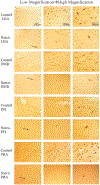Narp immunostaining of human hypocretin (orexin) neurons: loss in narcolepsy
- PMID: 16135770
- PMCID: PMC8765220
- DOI: 10.1212/01.wnl.0000175219.01544.c8
Narp immunostaining of human hypocretin (orexin) neurons: loss in narcolepsy
Abstract
Objective: To investigate whether neuronal activity-regulated pentraxin (Narp) colocalizes with hypocretin (Hcrt or orexin) in the normal human brain and to determine if Narp staining is lost in the narcoleptic human brain.
Background: Human narcolepsy is characterized by a loss of the peptide hypocretin in the hypothalamus. This loss could result from the degeneration of neurons containing hypocretin or from a more specific loss of the ability of these neurons to synthesize Hcrt. Narp has been found to colocalize with hypocretin in the rat hypothalamus.
Methods: We investigated the distribution of Narp in three normal and four narcoleptic human postmortem brains using immunohistochemistry with an antibody to Narp. Colocalization studies of Narp and hypocretin were also performed in two normal brains using immunohistochemistry with an antibody to Narp and an antibody to hypocretin.
Results: We found that Narp colocalizes with hypocretin in the lateral hypothalamic area (LHA), the dorsomedial hypothalamus (DMH), the dorsal hypothalamic area (DHA), and the posterior hypothalamic area (PHA) of the normal human. The number of Narp-positive neurons was reduced by 89% in these areas of the narcoleptic hypothalamus. In contrast, Narp staining in the paraventricular (Pa) and supraoptic nuclei (SO) of the human hypothalamus did not differ between normal and narcoleptic brains.
Conclusions: This finding supports the hypothesis that narcolepsy results from the specific loss of hypocretin neurons. Loss of hypothalamic Narp may contribute to the symptoms of narcolepsy.
Conflict of interest statement
Disclosure: The authors report no conflicts of interest.
Figures


Comment in
-
Narcolepsy: selective hypocretin (orexin) neuronal loss and multiple signaling deficiencies.Neurology. 2005 Oct 25;65(8):1152-3. doi: 10.1212/01.wnl.0000186118.96509.94. Neurology. 2005. PMID: 16247037 No abstract available.
References
-
- Peyron C, Faraco J, Rogers W, et al. A mutation in a case of early onset narcolepsy and a generalized absence of hypocretin peptides in human narcoleptic brains. Nat Med 2000;6:991–997. - PubMed
-
- Reti IM, Reddy R, Worley PF, Baraban JM. Selective expression of Narp, a secreted neuronal pentraxin, in orexin neurons. J Neurochem 2002;82:1561–1565. - PubMed
-
- Guilleminault C Narcolepsy syndrome. In: Kryger MH, Roth T, Dement WC, eds. Principles and practice of sleep medicine. 2nd ed. Philadelphia, PA: W.B. Saunders Company; 1994:549–561.
Publication types
MeSH terms
Substances
Grants and funding
LinkOut - more resources
Full Text Sources
Medical
